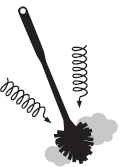Uncle John’s Bathroom Reader Weird Inventions (4 page)
Read Uncle John’s Bathroom Reader Weird Inventions Online
Authors: Bathroom Readers’ Institute

C
arjacking is terrifying. You’re just sitting in your car at a stoplight, when suddenly a thug runs up to your window with a gun and demands you get out and give him the car.
There aren’t a lot of ways to prevent such a sudden, and ultimately speedy, crime. But in South Africa, where carjacking is epidemic, an inventor did figure out a way to punish carjackers before they get away with it: fire. Lots of fire. Charl Fourie introduced the Blaster to the South African car-peripherals market in 1998, at a price of 3,900 rand (about $655 back then). At the first sign of trouble, the driver activates the Blaster from the steering column. The Blaster squirts flammable liquid from a holding tank in the trunk out of two nozzles under the driver-side door. The Blaster then emits an electric spark, which ignites the gas…and the carjacker.
T
he intimidating thing about tattoos—besides their outlaw associations—is that they’re so darned permanent. Pity the fellow with his ex-girlfriend’s name in ink. Barring expensive cover-ups or laser treatments, he’s doomed to a future of awkward first dates, trying to explain away the “Jennifer” on his arm.
But what if tattoos were rewritable? What if changing that “Jennifer” to a “Susan” was as easy as sending a text message? Researchers are looking into different ways to create modifiable body art. There’s already a patented process using magnetically-responsive inks to produce tattoos that can be redrawn with electrodes attached to the skin. Scientists at the Rensselaer Polytechnic Institute in New York take a different tack. Instead of using ink, they imagine a “tattoo” that’s really a digital display—a thin sheet of polymer, encapsulating billions of carbon nanotubes, implanted under the dermis and shining out through the skin.
Uses for this technology might include displaying emoticons to indicate what sort of mood we’re in, or jotting down messages where we know we won’t lose them. (Shades of the movie
Memento
.) The screens could even display vital medical information.
Or they could help avoid the embarrassment of a souvenir that lasts forever—even when love doesn’t.
A
gerbil’s life is a lonely one, spent mostly in a cage, running on that wheel and waiting for those few minutes a day when its owner decides to play with it. Sometimes a change of scenery is needed for the animal’s peace of mind, and for that reason, somebody invented the Gerbil Shirt.

With a series of tubes attached to both sides of a vest and two small chambers at the stomach, the Gerbil Shirt is basically a portable, wearable Habitrail. It allows gerbil owners to take their pet for a walk—just like dog owners do. The inventor even took safety into consideration. There are air vents throughout so that the animal can breathe easily, and the passageways have textured interiors so that it can maintain its balance, particularly on the vertical paths.
However, there is a serious downside. By allowing you to take your gerbil out into the wild, the Gerbil Shirt broadcasts to the world the fact that you are both a gerbil owner, and the kind of gerbil owner who wants and needs to take its gerbil out in public via a special shirt.
A
t the 2013 Consumer Electronics Show in Las Vegas, Samsung shocked and delighted almost nobody by presenting prototypes of an extremely thin, bendable cell phone and tablet computer, part of a product line called “Youm.” Instead of using sturdy materials like glass to build their Youms, Samsung opted to use a strong and flexible plastic. The proposed devices work by means of something called Organic Light-Emitting Diodes, which certainly sounds cool and futuristic.
Though indeed bendier than the average cell phone, the Youm phone isn’t flexible enough to do anything potentially useful, like, say, fold completely in half so it can be placed into a pocket. It can, however, be rolled into a tube.
Brian Berkeley, VP of display research and development at Samsung (who, incidentally, quit his gig at Apple in order to move to South Korea for the job), demonstrated the purported benefits of a flexible tablet on stage. “We have expanded the canvas available for content,” he said, pointlessly displaying a news-ticker-esque line of text scrolling across the edge of the tablet he had just bent in half.
U
ncomfortable keeping a gun around the house? Unable to figure out the buttons on one of those fancy alarm systems? The Hydreon Corporation has developed the perfect solution: FakeTV, a timer-operated device that tricks potential home invaders into thinking you’re home when you’re not. Crime prevention and TV: two great tastes that taste great together!
It’s about the size of a coffee cup, but it emits an LED light pattern as bright as a big-screen television, with shifting colors and motion to simulate, when seen through a window outside the house, an actual TV in action. Sensors turn it on at dusk and operate it for four hours (if you feel like pretending to turn in early), seven hours, or all the way until dawn (if you want to make robbers think you stayed up all night for a
Growing Pains
marathon). No matter which setting you choose, you’ll convince potential robbers—not to mention your neighbors—that 1) you’re always home, and 2) you never stop watching TV.

F
acial dimples—those indentations that accent a smile, making it at least 38 percent more adorable—are the result of a harmless deformity of a muscle in the cheek, the zygomaticus major. Usually, you have to inherit them from a parent. But what about those of us who lack such genetic good fortune? Must a dimpled cheek be born? Can it not be…made?
Inventor Martin Goetze thought so. In 1896 he patented the Dimple Drill. This contraption looked like a refugee from a woodworker’s bench, sort of a gimlet mechanism crossed with a draftsman’s compass. The dull tip, made of ivory or hard rubber, was applied to the cheek, and the handle cranked. The combination of gentle pressure and rotation would carve those darling divots into your mug in no time. The patent application claimed that the drill could be used to maintain and even deepen existing dimples, too.
And if boring craters into your face with a glorified auger seems a little extreme to you, well, nobody said that being adorable was easy.
A
s modern drivers, we all know the feeling of wanting to pay attention to the road but getting distracted by equally important activities like watching cat videos on our cell phones or eating a cheeseburger. The solution? Brain probes and robots, of course. Scientists at MIT are working on something called “Brainput” to help us multi-task more safely and effectively, because let’s face it: We’re never going to learn to actually pay attention to what we’re doing.
The system works like this: You attach two probes to your forehead, and, using what is purportedly science but sounds an awful lot like diabolical voodoo, the probes sense when your attention is drifting and notify a robot to pitch in and help you out (e.g., your car drives itself for a minute so you can focus on licking a dollop of errant mustard off of the steering wheel). If the concept of robots reading your mind causes you to repeatedly scream and then run way, don’t worry just yet: The technology has only been tested in a very basic form, in which the robot helps the user navigate a maze. Brainput’s application in real-life situations, like the driving-whilst-texting-and-noshing mentioned above is still but a distant dream/nightmare.

S
ometimes you gotta go when you’re on the go, but you don’t want to stop in order to go. Is there any way you can go while you go?
Yes, because Aston Waugh of East Orange, New Jersey, invented the Automobile Urinal. Anybody can pee into an old Snapple bottle; Waugh’s device is fully functional, more than merely a pee holder you throw out later. It consists of three parts: a hanging water tank, a miniature padded toilet bowl that the driver sits on while driving, and a waste-storage tank that stows neatly beneath the driver’s seat. After use, the driver flushes the device by opening a valve; water from the hanging tank flows through a tube into the toilet bowl, and from there into the storage tank underneath the seat. “For privacy,” the inventor advises, “the user may wrap a large towel around him or herself from the waist to the knees before undoing the clothing to facilitate urination.”
So you’re free to go, so long as you planned beforehand, and you’re not on a date or something. And you probably shouldn’t use your cell phone while you’re both driving and going to the bathroom.

D
espite the number of previously popular outdoor pastimes that’ve been deemed environmentally unfriendly in recent years, fishing and hunting among them, it still seems hard to believe that someone would have zeroed in on skipping stones as a seemingly fun thing that needed to be tweaked for political-correctness purposes.
But here’s the deal: Technically, most rocks are inorganic. You throw them in a river or lake, and they just sit there forever, where they grow smooth over time via natural erosion. Inventor Glen Davis simply didn’t think any of this would do, so he created the perfect stone for skipping, giving it “a smooth and continuous exterior surface with a substantially circular and smooth-edged outer perimeter” and “a hollowed, substantially elliptical and interior cavity,” thereby resulting in a greater likelihood of some serious skipping action.
Presumably as a result of the sort of legality that causes wing-shaped pieces of chicken containing no actual wing meat to be called “wyngs,” however, it must be noted that this handy-dandy item is technically not a biodegradable skipping stone but, rather, a “Water Skipping Article Incorporating Elliptical Outline and Hollowed Interior Core.” Make it out of something biodegradable, and you’re saving the Earth, one half-hearted stone’s throw at a time.
